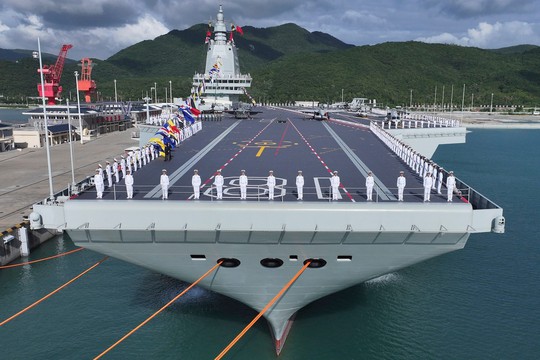The Fujian and its strike group represent a strategic game changer that will bring Beijing closer to its goal of eroding U.S. maritime primacy in its backyard. A commissioning and flag-presenting ceremony is held for the Fujian, China's third aircraft carrier, at a port in Sanya city, in Hainan province, on Nov. 5.
Photo: Xinhua
China’s efforts to blunt American maritime power in the Pacific, a region the United States has long considered its domain, received a major boost this month with the official launch of its third — and most advanced by far — aircraft carrier, the Fujian, ‘The Washington Post’ writes.
The 80,000-ton supercarrier, which can accommodate about 60 aircraft and will be accompanied by as many as 10 warships, will dramatically narrow the naval capability gap between the U.S. and China, according to American, Japanese, Taiwanese and Chinese analysts. It will also enable Beijing to further intimidate rivals in the South China Sea and Taiwan Strait.
“We’re really entering a new era here,” said Lyle Goldstein, director of Asia engagement at Defense Priorities, a Washington-based think tank.
The impact of China's new Fujian aircraft carrier
The Fujian will help China’s goal of expanding from a coastal navy to a Pacific power.
China was already a significant adversary: It has the world’s largest navy by number of ships, biggest arsenal of ground-launched ballistic and cruise missiles, and largest active military service, with a standing army of 2 million soldiers.
Now, the launch of the Fujian will bring Beijing closer to its goal of eroding U.S. maritime primacy in its backyard, not least because the warship uses electromagnetic catapults to launch planes, making China the only country, after the United States, to have developed and built this technology.
“It’s not a small jump,” Goldstein said of the Fujian’s catapults. “It’s literally doubling or tripling — maybe even quadrupling — the combat lethality.”
The supercarrier is critically important to China’s Xi Jinping, the country’s strongest leader in decades and one who wants a world-class military with capabilities to match the U.S. by 2049.
Underscoring how central the Fujian is to this goal, state broadcaster CCTV last week reported that Xi “personally” made the decision to adopt electromagnetic catapult technology. During the launch ceremony on the southern military stronghold of Hainan, Xi — dressed in a green military shirt — pressed the catapult button and sent the launch shuttle forward “like an arrow leaving the string of a bow,” CCTV said.
The carrier fulfills multiple goals for Chinese military strategy: Its strike group — comprising fighter jets, stealth fighters, surveillance planes and cruisers laden with anti-ship missiles — will bolster Beijing’s intimidation of rival claimants in the disputed waterways of the South China Sea.
China’s third aircraft carrier uses an advanced integrated power system that backs up conventional steam turbines with diesel generators to provide addition propulsion and electricity for other systems.
While less advanced than nuclear-powered American carriers, this more efficient system allows a displacement of over 80,000 metric tons and a larger air wing — around 60 aircraft compared to 44 on the older Shandong.
The Fujian will also add heft to China’s threats to blockade Taiwan, the self-governing island Beijing claims as its territory.
But the U.S. projects its power around the world, while Beijing can concentrate on Asia. That makes the military balance in the region look far more precarious than before, said Toshi Yoshihara, a senior fellow at the Center for Strategic and Budgetary Assessments, a Washington-based think tank.
 Photo: Xinhua
Photo: Xinhua
China matches the U.S. with catapult technology
The speed of Chinese progress has been dramatic.
When China commissioned its first aircraft carrier, the Liaoning, in 2012, it was widely dismissed as an outdated Soviet design retrofitted from a secondhand hull. Its next attempt, the Shandong, in 2019, was built in China but based on the Liaoning.
Now, Beijing has unveiled a domestically designed supercarrier with electromagnetic catapults. This launch system uses rapidly moving magnetic fields to accelerate aircraft along a track and fling them into the sky, enabling the Chinese military to launch heavier planes and at a far faster rate than before.
The generators also power the carrier’s three electromagnetic catapults — a game-changing technology that dramatically raises combat lethality.
Even allowing for the hyperbole of Chinese propaganda, the Fujian is shaping up to be a “completely different beast” from its predecessors, said Joaquin Camarena, a former U.S. Marine Corps intelligence officer who tracks China’s military modernization.
The carrier will operate as a floating command center
The Fujian has a significantly enhanced ability to detect enemy targets and act as a floating command center and air base. This will help deny adversaries access to the seas and skies in a potential conflict in the South China Sea or over Taiwan.
The carrier’s improved systems make it a more effective floating command center and airbase capable of operating for long periods far from Chinese shores.
The three KJ-600 early-warning and control aircraft, with their large fuel tanks and powerful radars, significantly enhance the carrier group’s ability to detect enemy targets beyond the horizon.
That additional detection information boosts the lethality of the air wing’s next-generation J-35 stealth fighters and J-15 electronic warfare jets.
This plane, China’s answer to the U.S. E-2 Hawkeye, made its debut during a grand military parade in Beijing in September. Its extended radar range — at least double that of the helicopters used on China’s older carriers — enables the KJ-600 to look over the horizon, gather real-time information and relay commands, boosting the carrier’s ability to conduct complex defensive operations and offensive strikes far out at sea.
“They have bridged that gap with the U.S., at least in theory,” said Collin Koh, an expert on the Chinese military at the S. Rajaratnam School of International Studies in Singapore. “That certainly expands the PLA Navy’s far-seas combat capability.”
China can now credibly challenge the U.S. in the Pacific
Countering American carrier dominance in the Asia-Pacific region has been an obsession for Beijing ever since the 1990s, when a crisis over Taiwan led the U.S. to send multiple aircraft carriers through the Taiwan Strait — infuriating Beijing over what it deemed an “internal” affair.
Decades later, Beijing has hailed the arrival of the Fujian as evidence it can effectively challenge U.S. naval dominance across critical maritime domains in the Pacific.
The U.S. had relied on geographical lines to contain China during the Cold War — mainly the first and second island chains, which run south from Japan, forming maritime chokepoints to access the Pacific Ocean.
“China wants to push U.S. forces out from inside the first island chain and then be able to operate freely within the second island chain,” said Moriki Aita, a research fellow at National Institute for Defense Studies, a Tokyo-based think tank under Japan’s Defense Ministry.
In May and June, China’s two older carriers held simultaneous drills in the Western Pacific near Japan’s outlying islands, with their associated aircraft conducting over 1,100 sorties, in a display of Beijing’s growing confidence.
Chinese aircraft carriers conduct joint ocean sortie:
 Photo: tv9english.com
Photo: tv9english.com
read more in our Telegram-channel https://t.me/The_International_Affairs

 12:21 19.11.2025 •
12:21 19.11.2025 •























